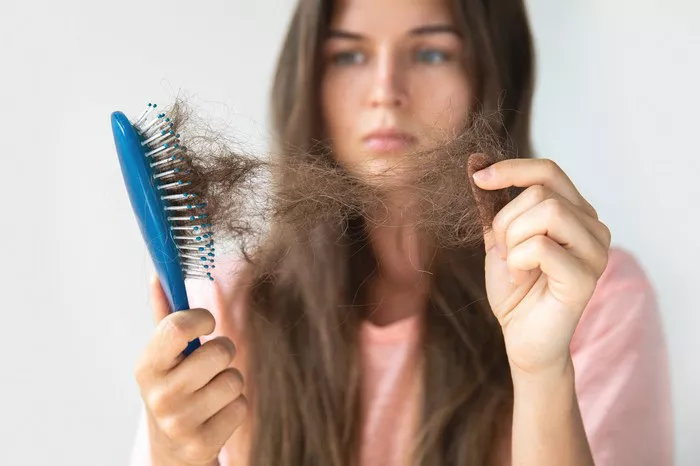Frizz – the nemesis of smooth, sleek hair – seems to be a universal woe for many, regardless of hair type. While it’s often associated with curly or wavy hair, straight hair isn’t immune to the frizz conundrum either. Despite its seemingly uniform appearance, straight hair can still fall victim to frizz, leaving many wondering why. In this article, we’ll delve into the intricate science behind why straight hair gets frizzy, exploring the factors at play and offering insights into effective management strategies.
The Structure of Straight Hair: A Closer Look
To comprehend why straight hair can succumb to frizz, it’s essential to understand its structure. At its core, each strand of hair consists of three layers: the cuticle, cortex, and medulla. The cuticle, the outermost layer, is comprised of overlapping scales that lie flat when the hair is healthy, providing a smooth surface. The cortex, the middle layer, contains keratin proteins responsible for the hair’s strength, elasticity, and color. Lastly, the medulla, found primarily in thick hairs, serves as the innermost layer.
Straight hair typically has a round or oval-shaped cross-section, contributing to its smooth texture and reflective properties. This uniform shape allows light to bounce off the hair’s surface, giving it a glossy appearance. However, despite its seemingly perfect structure, straight hair is susceptible to frizz due to various internal and external factors.
Moisture Levels: The Key Culprit
One of the primary reasons why straight hair experiences frizz is moisture imbalance. Hair strands are highly porous, meaning they can absorb and release moisture from the environment. When the humidity levels rise, straight hair can absorb excess moisture from the air, causing the cuticle to swell. As a result, the overlapping scales on the cuticle lift, creating an uneven surface that appears frizzy and unruly.
Moreover, straight hair tends to have a lower natural oil content compared to curly or wavy hair types. These natural oils, produced by the scalp, help to keep the hair shaft lubricated and moisturized. Without an adequate oil barrier, straight hair is more prone to moisture absorption, exacerbating frizz.
Environmental Factors and Frizz Formation
Beyond humidity, environmental factors such as heat, wind, and pollution can also contribute to frizz in straight hair. Exposure to high temperatures, whether from styling tools or environmental sources like the sun, can cause the hair’s proteins to denature, leading to structural damage and increased porosity.
Additionally, strong winds can disturb the hair’s cuticle layer, causing friction and tangling, which can result in frizz. Pollution, including airborne particles and chemicals, can deposit onto the hair shaft, creating a barrier that disrupts the smooth surface of the cuticle.
Chemical Treatments and Styling Practices
Chemical treatments and styling practices can also play a significant role in exacerbating frizz in straight hair. Processes such as coloring, bleaching, and chemical straightening can weaken the hair’s structure, making it more susceptible to moisture imbalance and damage. These treatments often involve the use of harsh chemicals that can strip the hair of its natural oils and alter its texture, leading to frizz and dryness.
Furthermore, frequent use of heat styling tools such as flat irons and blow dryers can contribute to frizz by depleting the hair’s moisture levels and causing heat damage. Improper styling techniques, such as rough towel-drying or brushing the hair when wet, can also create friction and damage the cuticle, resulting in frizz.
Effective Management Strategies for Frizz-Prone Straight Hair
While frizz in straight hair may seem inevitable, there are several strategies that individuals can employ to manage and minimize its occurrence:
1. Hydration: Maintaining optimal hydration levels is crucial for preventing frizz in straight hair. Using moisturizing shampoos and conditioners can help replenish lost moisture and nourish the hair shaft. Additionally, incorporating hydrating hair masks and leave-in treatments into your routine can provide an extra layer of protection against environmental stressors.
2. Protective Styling: Implementing protective hairstyles, such as braids or buns, can shield the hair from external elements and minimize friction-induced frizz. Opting for satin or silk hair accessories can also help reduce friction and prevent breakage.
3. Heat Protection: Prioritize using heat protectant products before styling your hair with heat tools to minimize damage and preserve moisture. Adjusting the heat settings on styling tools to lower temperatures can also mitigate heat-related frizz and damage.
4. Regular Trims: Schedule regular trims with your hairstylist to remove split ends and prevent further damage. Keeping the hair’s ends healthy and free from damage can help maintain a smooth, frizz-free appearance.
5. Avoid Over-Washing: Limiting the frequency of hair washing can help prevent stripping the hair of its natural oils, which can exacerbate frizz. Instead, opt for dry shampoo or co-washing between wash days to refresh the hair without over-drying it.
6. Anti-Frizz Products: Incorporate anti-frizz serums, oils, or creams into your styling routine to smooth the hair’s cuticle and control frizz. Look for products containing ingredients such as silicone, argan oil, or shea butter, which can help seal the hair shaft and create a barrier against humidity.
7. Protective Barrier: Consider using a lightweight hair oil or serum to create a protective barrier against environmental moisture and pollutants. Applying a small amount of oil to the ends of the hair can help seal the cuticle and keep frizz at bay.
In conclusion, while straight hair may appear smooth and uniform, it is not immune to frizz. Understanding the underlying causes of frizz, such as moisture imbalance, environmental factors, and styling practices, is essential for effectively managing and minimizing its occurrence. By adopting proper hydration techniques, protective styling methods, and using appropriate hair care products, individuals with straight hair can achieve a sleek, frizz-free look regardless of the weather conditions.


